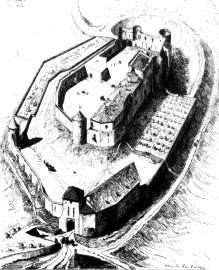Jean III de Grailly, captal de Buch



Sir Jean III de Grailly, Captal de Buch KG (d. Paris, 7 September 1376), son of Jean II de Grailly, Captal de Buch, Vicomte de Benauges, and Blanch de Foix,[2] was a cousin of the Counts of Foix and a military leader in the Hundred Years' War who was praised by the chronicler Jean Froissart as an ideal of chivalry.
Attached to the English side in the conflict, he was made Count of Bigorre by Edward III of England, and was also a founder and the fourth Knight of the Garter in 1348.[3] He played a decisive role as a cavalry leader under Edward, the Black Prince in the Battle of Poitiers (1356), with de Buch leading a flanking move against the French that resulted in the capture of the king of France (John II), as well as many of his nobles. John was taken to London by the Black Prince and held to ransom.[4][5]
In 1364 he commanded the forces of Charles II of Navarre in Normandy, where he was defeated and captured by Bertrand du Guesclin at Cocherel.[6] After his release the following year, he defected to the French side and was made lord of Nemours by Charles V of France. However, he soon re-established his loyalty to the English, and in 1367 he went to Spain with the Black Prince, fighting at the Battle of Nájera.[7] Here he again faced Bertrand du Guesclin, but this time it was du Guesclin who was captured, and the Captal was put in charge of the prisoner. He was rewarded for his service by being made the Constable of Aquitaine in 1371.
Again fighting for the English, he commanded an English relief force when the French attacked La Rochelle in 1372. While attempting to lift the siege of Soubise his force was surprised by a French force led by Owain Lawgoch, a Welsh soldier of fortune in the French service. The Captal and Sir Thomas Percy, seneschal of Poitou, were captured. The Captal spent the remainder of his life as a prisoner at the Temple in Paris because Charles V believed him too dangerous to ransom back to the English.
Froissart gives an account of the Captal de Buch's chivalry and courage at the time of the peasant uprising in 1358 called the Jacquerie (see link).
Jean de Grailly was a prisoner of the French since 1372. He had refused his freedom as it would have meant taking up arms against the king of England, which he swore never to do. His personal allegiance to Prince Edward of England, the Black Prince, was so strong that upon hearing of his death, he lost all resolve, refused food and died a few days later.[8]
Since he left no heirs from his marriage to Rose d' Albret, his uncle, Archambaud, count of Foix and of Bigorre took the title Captal de Buch, which passed to his descendants the Counts of Foix.
 |
|
Notes
- ↑ British Museum Collection
- ↑ Beltz, George, Memorials of the Most Noble Order of the Garter From its Foundation to the Present time, (Kessinger Publishing), 29-30.
- ↑ Beltz, 30.
- ↑ Nicolle, David, and Graham Turner, Poitiers 1356: The Capture of a King, (Osprey Publishing, 2004), 17.
- ↑ Patourel. Norman and Plantagenet. pp. 20-21
- ↑ Nicolle, 17.
- ↑ Wagner, John A., Encyclopedia of the Hundred Years War, (Greenwood Publishing Group, 2006), 139.
- ↑ Harvey, John (1976). The Black Prince and his age. London: Biddles Ltd. p. 121.
- ↑ Macauly, Gregor (2010). "The Arms of the Founder Knights of the Garter". The New Zealand Armorist: The Journal of the Heraldry Society of New Zealand. 114 (Autumn 2010): 9–11.
References
- Beltz, George, Memorials of the Most Noble Order of the Garter From its Foundation to the Present time, Kessinger Publishing.
- Nicolle, David, and Graham Turner, Poitiers 1356: The Capture of a King, Osprey Publishing, 2004.
- Le Patourel, John (1984). Jones, Michael, ed. Feudal Empires:Norman and Plantagenet. London: Hambledon Continuum. ISBN 0-907628-22-2. Retrieved 26 September 2012.
- Turnbull, Stephen. The Book of the Medieval Knight. London: Arms and Armour Press, 1985. ISBN 0-85368-715-3
- Wagner, John A., Encyclopedia of the Hundred Years War, Greenwood Publishing Group, 2006.